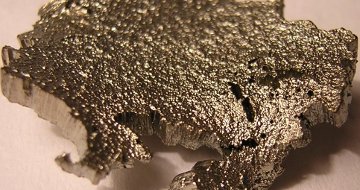
Scandium
Scandium General
| Name:Scandium | Symbol:Sc |
| Type:Transition Metal | Atomic weight:44.9559 |
| Density @ 293 K:3.0 g/cm3 | Atomic volume:15.0 cm3/mol |
|
Discovered:
Scandium was discovered by Lars F. Nilson in 1879 using spectral analysis of the minerals euxenite and gadolinite. The element is named after the Latin word 'Scanda', meaning Scandinavia because the element occurs in rare minerals found there. |
|
Scandium States
| State (s, l, g):solid | |
| Melting point:1813.2 K (1540 °C) | Boiling point:3103 K (2830 °C) |
Scandium Energies
| Specific heat capacity: 0.6 J g-1 K-1 | Heat of atomization:378 kJ mol-1 |
| Heat of fusion:14.10 kJ mol-1 | Heat of vaporization :314.20 kJ mol-1 |
| 1st ionization energy:631 kJ mol-1 | 2nd ionization energy:1235 kJ mol-1 |
| 3rd ionization energy:2389 kJ mol-1 | Electron affinity:18.1 kJ mol-1 |
Scandium Oxidation & Electrons
| Shells:2,8,9,2 | Electron configuration:[Ar] 3d1 4s2 |
| Minimum oxidation number:0 | Maximum oxidation number:3 |
| Min. common oxidation no.:0 | Max. common oxidation no.:3 |
| Electronegativity (Pauling Scale):1.36 | Polarizability volume:17.8 Å3 |
Scandium Appearance & Characteristics
| Structure:hcp: hexagonal close pkd | Color:silvery-white |
| Hardness:mohs | |
|
Harmful effects:
Scandium is a suspected carcinogen. |
|
|
Characteristics:
Scandium is a soft, light, silvery-white metal, which becomes slightly tinged with yellow or pink when exposured to air. Scandium is almost as light (low density) as aluminum but it has a much higher melting point. It is therefore of potential specialty use in aircraft - scandium will not be used generally because it is much more expensive than aluminum. Scandium reacts with many acids. Uses: Scandium is used in aluminum-scandium alloys for aerospace industry components and for sports equipment. It is used to make high intensity lights and light bulbs. The radioactive isotope 45Sc is used in oil refineries as a tracing agent. |
|
Scandium Reactions
| Reaction with air:vigorous, ⇒ Sc2O3 | Reaction with 6 M HCl:mild, ⇒ H2, ScCl3 |
| Reaction with 15 M HNO3:mild , ⇒ Sc(NO3 )3 | Reaction with 6 M NaOH:none |
Scandium Compounds
| Oxide(s):Sc2 O3 | Chloride(s):ScCl3 |
| Hydride(s):ScH3 |
Scandium Radius
| Atomic radius:162 pm | Ionic radius (1+ ion):pm |
| Ionic radius (2+ ion):pm | Ionic radius (3+ ion):88.5 pm |
| Ionic radius (2- ion):pm | Ionic radius (1- ion):pm |
Scandium Conductivity
| Thermal conductivity:15.8 W m-1 K-1 | Electrical conductivity:1.5 x 106 S m-1 |
Scandium Abundance & Isotopes
| Abundance earth's crust:22 parts per million by weight, 10 parts per million by moles | |
| Abundance solar system:40 parts per billion by weight, 1 part per billion by moles | |
| Cost, pure:$1400 per 100g | |
| Cost, bulk:$ per 100g | |
|
Source:
Scandium is not found free in nature but is found combined in minute anmounts in over 800 minerals. Rare minerals from Scandinavia and Madagascar (thortveitite, euxenite, and gadolinite) are the only known concentrated sources of the element. Commercially, scandium is obtained as a by-product of uranium refining. |
|
|
Isotopes:
Scandium has 13 isotopes whose half-lives are known, with mass numbers 40 to 52. Of these, one is stable: 45Sc. |
|
Scandium Other
|
Other:
|
|
Prev: Calcium Next: Titanium |